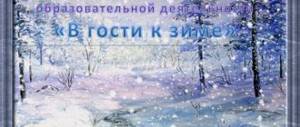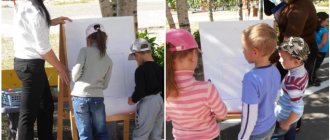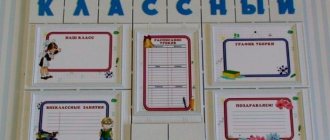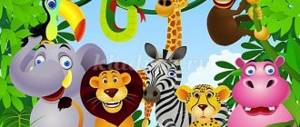Long-term plan for leisure activities in the middle group
Yulia Solodunova
Long-term plan for leisure activities in the middle group
September
1. Entertainment “We play and sing, we live a lot of fun!”
Goal: to bring joy to children and help relieve emotional stress.
2. Theatrical entertainment “Visiting Grandma Fedora.”
Goal: to encourage children to actively participate in theatrical play; learn to convey the emotional state of a literary character using various means of expression; develop intonation expressiveness of speech; cultivate friendly partnerships.
3. Entertainment “Fixies visiting the guys.”
Goal: continue to introduce children to tools and their purpose; teach to classify and group objects; develop logical thinking, speech, fine motor skills; enrich vocabulary; develop respect for the work of those around you.
4. Physical education “My funny, ringing ball!”
Goal: to cheer up children; develop interest in outdoor games, improve children’s health; cultivate collectivism, the ability to play in a team, and empathy.
5. “Festival of colors and balloons.”
Goal: to evoke a positive emotional response in children and create a good mood.
October
1. Physical education “Day of Happy Frogs.”
Goal: improve children's health; develop dexterity, speed, spatial orientation; cultivate collectivism, a sense of camaraderie, and the ability to empathize with the team.
2. Dramatization based on the fairy tale “Teremok”.
Goal: to expand children’s understanding of the diversity of Russian folklore, to cultivate interest in Russian folk games, using counting rhymes and tongue twisters.
3. Entertainment “Funny Garden”.
Goal: to consolidate children’s understanding of vegetables; enrich the active vocabulary; cultivate a desire to work and help a fairy-tale character; develop attention, memory, examination and analysis abilities.
4. Entertainment “Visiting Lesovichka.”
Goal: to create a joyful mood in children; evoke emotional responsiveness, promote the development of interest in the world around us.
5. Autumn Festival.
November
1. Musical and theatrical entertainment “Delicious Pie”.
Goal: to enrich children’s speech, develop a sustainable interest in theatrical play activities, cultivate positive moral ideals, the desire to be responsive, create a friendly atmosphere of joint creativity between children and adults.
2. Entertainment “Warmth from the sun, goodness from mommy.”
Goal: to evoke an emotional response in children, to cultivate love and respect for their mother.
3. Table theater “The Wolf and the Seven Little Goats.”
Goal: to develop active speech and creative abilities of children, the ability to carefully follow the course of a fairy tale and the actions of fairy-tale characters.
4. Physical education “Travel to a desert island.”
Goal: to improve the skills of performing game exercises with jumping (moving forward on two legs, jumping from a place, jumping over an obstacle); consolidate the ability to coordinate movements with music, develop a sense of rhythm, agility, strength, endurance.
5. Entertainment “Journey to a forest clearing.”
Goal: to form in children the idea and need for friendly communication with each other; teach to observe basic rules of politeness and communication culture.
December
1. Physical entertainment “Visiting the Buffoon.”
Goal: to create a positive emotional mood, to promote the development of movements during the game, to form a value attitude towards physical education, to bring joy and pleasure from joint activities.
2. Table theater “Zayushkina hut”.
Goal: to develop active speech and creative abilities of children, the ability to carefully follow the course of a fairy tale and the actions of fairy-tale characters.
3. “Walk through the winter forest” - entertainment to familiarize preschoolers with the world around them.
Goal: to create a joyful mood in children, evoke emotional responsiveness, promote the development of interest in the world around them; consolidate and expand children's knowledge about the signs of winter, animals, trees; develop creative imagination, memory, attention, speech.
4. “Visiting Petrushka” - musical and theatrical entertainment.
Goal: to bring joy to children, develop their attention; encourage children to engage in basic musical and creative expressions.
5. New Year's holiday.
January
1 Physical education “Winter fun”.
Goal: to consolidate children’s knowledge about winter fun, increase the level of physical activity; develop the ability to act in a team and pass the baton.
2. Musical entertainment “Let’s play and guess.”
Goal: continue to introduce children to Russian folk noise instruments; develop musical memory, attention, sense of rhythm; instill a love for folk music.
3. Demonstration of the tabletop theater "Masha and the Bear".
Goal: to evoke joy from meeting your favorite fairy tale characters.
4. Game - fun “Mice are playful”.
Goal: to create a joyful mood in children, to make them want to participate in the game with everyone else.
February
1. Physical entertainment “Brave Boys”.
Goal: to form a sustainable interest in physical education and sports; improve health when doing physical exercises; develop physical qualities: agility, speed, flexibility and coordination of movements; to cultivate in children courage and will to overcome obstacles.
2. Theatrical game “Mitten”.
Goal: to teach children to actively participate in joint games, to depict the characteristic behavior of the characters. Cultivate friendship and the ability to act in concert.
3. Entertainment “Don’t touch the matches, there’s fire in the matches!”
Goal: to consolidate children’s knowledge that it is dangerous to play with fire; cultivate a sense of caution and self-preservation.
4. Entertainment “Cheerful clown and clowns.”
Goal: to create a joyful mood in children, to make them want to participate in the game with everyone else.
March
1. Musical and theatrical entertainment “Tales of Grandma Zabavushka.”
Goal: continue to introduce children to Russian folk tales; develop the ability to solve riddles; develop children's oral speech in various forms and activities; increase interest in various types of games.
2. “Visiting a fairy tale” - entertainment.
Goal: to evoke joy from meeting your favorite fairy tale characters.
3. Physical education “Secrets of health.”
Goal: to create a positive emotional mood in children, a cheerful, cheerful mood; develop motor skills: speed, flexibility, coordination; practice rope walking, jumping on two legs; consolidate children's knowledge in the names of familiar modes of transport.
4. Entertainment “The Adventures of Little Kapitoshka.”
Goal: to form and systematize children’s knowledge about water, its purpose, use; to form a cognitive interest in nature, develop observation skills; intensify mental activity, enrich and activate the vocabulary.
5. Entertainment for March 8th.
April
1. Sports entertainment “Journey into space”.
Goal: to consolidate children's knowledge about space; develop the ability to use basic types of movements in game situations; to cultivate curiosity, courage, dexterity, and endurance in children.
2. Musical entertainment “Our fun concert.”
Goal: to create a joyful mood in children while singing, moving and playing to music.
3. Table theater. Fairy tale by V. Suteev “Under the mushroom”.
Goal: to teach children to dramatize a simple fairy tale using a tabletop theater: to combine movement and text in the role, to develop a sense of partnership.
4. “Visiting the Traffic Light” - entertainment.
Goal: to reinforce the use of traffic lights in a game situation; teach children safe behavior on the street, rules of behavior on the bus, on the road.
5. Spring fun.
May
1. Entertainment “Musical Kaleidoscope”.
Goal: to teach children to listen and perceive music; develop creative thinking, rhythmic hearing; cultivate interest and love for music through play.
2. Entertainment “Playing a fairy tale.”
Goal: to help the child unleash his creative potential; develop speech, attention, imagination; arouse interest in Russian traditions; cultivate kindness and a desire to help.
3. “Visiting the Bees” - entertainment for children.
Goal: to create a joyful and cheerful mood in children, to expand children’s knowledge about bees, honey and its benefits for humans.
4. Sports entertainment “Fun Starts”.
Goal: to give children pleasure from joint motor activity in sports games, relay races, to increase motor activity; develop spatial orientation; to cultivate the competitive spirit of preschoolers and mutual assistance.
5. Fun “It’s fun to walk together.”
Goal: to develop communication skills and bring joy to children.
Fairy tale quizzes
Quiz on fairy tales in kindergartens:
- Summarize children's knowledge about fairy tales,
- Develops friendliness and the ability to be united,
- Activate creativity
- Create a positive emotional mood,
- Form a personal position of perception of a fairy tale.
Important ! A quiz on fairy tales in the preparatory group of the kindergarten “Visiting a Fairy Tale” involves preliminary work in the form of listening to audio recordings, conversations on the content, and looking at illustrations.
The following equipment is used for fairy tale quizzes in the preparatory group:
- Prepared presentation,
- Cut-out pictures depicting fairy tale characters,
- Audio recordings with the voices of the characters,
- Visual material with tasks,
- Tokens.
Literary quiz in the senior group
The quiz for the senior group “Our favorite fairy tales” involves dividing the group into 2 teams: “suns” and “sparrows”. There is a fair jury at the quiz. The event begins with a warm-up, during which children answer questions. Then follows a second competition, where a fairy tale is read out, and the children must say what kind of work it is. Afterwards, riddles and physical education are used.
How to quickly teach numbers from 1 to 10 to a preschooler
Lesson structure and plan
The structure of the lesson includes:
- Traditional forms of holding (matinees, evenings, concerts, quizzes, living rooms).
- Literary games (lotto, “zigzag of luck”, “tic-tac-toe”).
- Fairs (competitions, meetings with poets, journalists), amateur performances.
- An auction is a game according to the rules of the auction; the winnings go to those who give the correct answer to the question asked.
- A game-trip to the poet’s house-museum, to the places where the action is taking place, to the writer’s homeland.
- Non-traditional forms of presentation: flashbook, information digest, literary kaleidoscope, “storysec” (“bag of stories”), “magic backpack”, book fashion show.
Note ! The classes develop skills of determination, perseverance, and a sense of cohesion. This evokes an emotional response and a feeling of joy in the child. After leisure time, preschoolers enrich their active gaming experience, strengthen their skills of safe behavior in games, and develop a sense of rhythm with the help of exercises accompanied by music.
Leisure plan:
- The theme of the evening is determined. Goals, tasks.
- Introduction.
- An evening is held by combining different types of arts (music, visual arts, fiction). This could be a concert, a quiz, character performances, songs.
- During the event there are elements of physical and intelligent activity: dancing, listening, dancing, completing tasks, guessing riddles.
- Surprises are not forgotten: you can make a wish come true with the help of a seven-colored flower, ask your parents to read a poem by A.S. Pushkin, or watch a puppet theater.
Quiz questions
Literary quiz questions in a senior group on fairy tales can be:
- Puzzles,
- "Continue the poem..."
- Pictures with images of heroes, and the child answers who it is.
Examples:
- He brought it to the forest and left it under the tree,
Not in spring and not in autumn, but in fierce winter!
Warm tears freeze in the cold,
Nastenka was saved by the real... (Morozko).
- Children are given cards, 3-5 identical for several children. They depict: Serpent-Gorynych, Koschey the Immortal, Geese-swans, Alyonushka's sister, Little Humpbacked Horse. It is advisable to sign these cards. Then the teacher asks characterization questions to the characters. For example, who breathes fire when they're really angry? What birds stole children for Baba Yaga? Who was able to save Ivanushka from death in a cauldron of boiling water? The questions are asked at random to confuse the children.
Quiz questions on the works of S. Marshak
Fairy tales for quizzes
The most striking and popular fairy tales for quizzes are:
- “Thumbelina” G.Kh. Andersen,
- "Pinocchio" by A. Tolstoy,
- “Little Red Riding Hood” and “Cinderella” by C. Perrault,
- “Moidodyr” by K. Chukovsky,
- "Snow White" by the Brothers Grimm,
- “Aibolit” by K. Chukovsky,
- “Puss in Boots” by C. Perrault,
- “Mustachioed and Striped” by S. Marshak,
- “Turnip”, “Three Little Pigs”, “Kolobok”, “Teremok”.
Conducting a quiz in the junior group of preschool educational institutions
Additional Information . An interesting version of the game would be for children to guess the name of the fairy tale, and for parents to guess the author of the work. This will help all participants actively participate in the process of the literary evening, creating vivid emotions and impressions.
How to make a privacy corner in a kindergarten with your own hands




